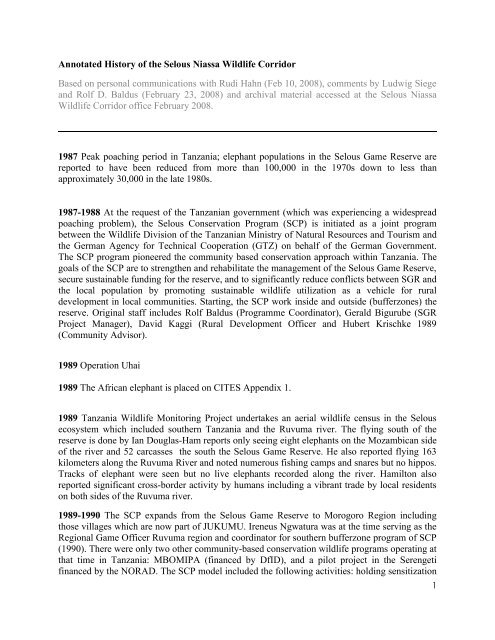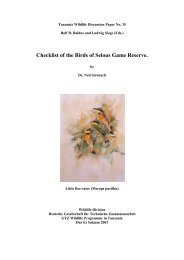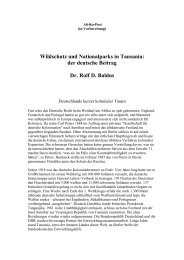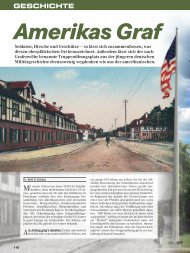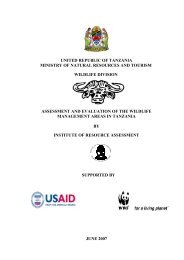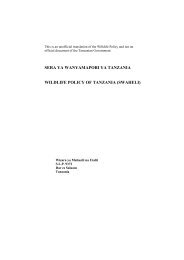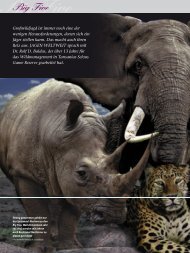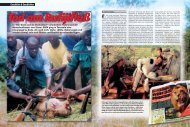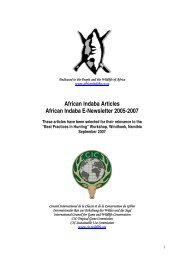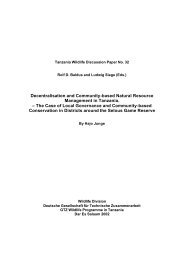Annotated History of the Selous Niassa Wildlife Corridor
Annotated History of the Selous Niassa Wildlife Corridor
Annotated History of the Selous Niassa Wildlife Corridor
Create successful ePaper yourself
Turn your PDF publications into a flip-book with our unique Google optimized e-Paper software.
equest. However a brief reconnaissance trip was taken by vehicle in <strong>the</strong> area later that year toassess <strong>the</strong> status <strong>of</strong> wildlife, poaching and human settlements in <strong>the</strong> area.1998 With funding and technical support from Frankfurt Zoological Society, GTZ, MNRT, andTAWIRI an aerial wildlife census for <strong>the</strong> <strong>Selous</strong> Game Reserve is undertaken and includes <strong>the</strong>proposed <strong>Corridor</strong> area for <strong>the</strong> first time.1998 An agreement is made with <strong>the</strong> Permanent Secretary MNRT, exploring <strong>the</strong> possibility <strong>of</strong><strong>the</strong> <strong>Selous</strong> <strong>Niassa</strong> <strong>Wildlife</strong> <strong>Corridor</strong>.August 1998 Rolf Baldus returns to Tanzania as a CBC advisor to <strong>the</strong> Tanzanian governmentand to rehabilitate <strong>the</strong> Saadani Game Reserve.October 1998 <strong>Niassa</strong> Game Reserve conducts an aerial wildlife census1998 National Mining Act is passed1999 InWEnt begins assisting in policy development and capacity building aiming at regionalpartnerships in Sou<strong>the</strong>rn and Eastern Africa including Tanzania and Mozambique. To facilitatetrans-boundary dialogue InWent launched <strong>the</strong> capacity building program TRANSNET: Transboundaryand Sustainable Management <strong>of</strong> Natural Resources for Regional Integration and RuralDevelopment in <strong>the</strong> SADC and EAC regions.13 February 1999 Tanzanian Local Government Law is approved with <strong>the</strong> intent to improvepolitical, administrative and financial decentralization throughout Tanzania.1999 Rolf D. Baldus and Rudi Hahn negotiate with Tropical Ecology Support Programme(TOEB) <strong>of</strong> GTZ during a seminar in Vilm/Germany to co-finance a research project on elephantmigration in <strong>the</strong> corridor in order to collect scientific data. After a tender in Germany <strong>the</strong> Berlinbased Institute for Zoo and <strong>Wildlife</strong> Research is awarded <strong>the</strong> contract.1999 The Land Act and Village Land Act No 4 <strong>of</strong> 1999 are passed. All land is classified as ei<strong>the</strong>rgeneral, village or reserved land. However <strong>the</strong> Act also legally devolves power to village levelorgans, particularly <strong>the</strong> Village Council to decide on land issues O<strong>the</strong>r changes include <strong>the</strong>institutionalization <strong>of</strong> participatory and transparent mechanisms in land allocation, determination<strong>of</strong> use, appropriation or access mechanisms and resolving conflicts related to land ownership anduse. These changes have significant implications for utilization, access and conservation <strong>of</strong>natural resources1999 The SCP program approaches <strong>the</strong> Director <strong>of</strong> <strong>Wildlife</strong> Emmanuel Severre about expanding<strong>the</strong> SCP model to encompass a wildlife corridor between <strong>the</strong> <strong>Selous</strong> and <strong>Niassa</strong> Game reserves.The Director asked for fur<strong>the</strong>r evidence <strong>of</strong> viable wildlife populations and <strong>the</strong> location <strong>of</strong>existing human settlements within <strong>the</strong> proposed <strong>Corridor</strong>.June 1999 An application for $15,000 PDFA grant is submitted to <strong>the</strong> UNDP. Proposedactivities include collecting ecological data, surveying human settlements and identifying village4
oundaries. The PDFA focuses exclusively on <strong>the</strong> sou<strong>the</strong>rn villages <strong>of</strong> <strong>the</strong> proposed corridor as itassumed that all <strong>the</strong> nor<strong>the</strong>rn villages will be supported through <strong>the</strong> SCP/GTZ programAugust 1999 A reconnaissance trip was made with Rudi Hahn (SCP), Dr. Drescher from <strong>the</strong>German Embassy, <strong>Selous</strong> sector wardens and antipoaching staff and village game scouts as wellas local guides. The objective was to collect first hand information about <strong>the</strong> proposed <strong>Selous</strong><strong>Niassa</strong> <strong>Wildlife</strong> <strong>Corridor</strong> including verification <strong>of</strong> wildlife populations, poaching status,information about human activities and settlements, wild fires and infrastructure. The 10 day tripwas conducted mostly on foot and covered approx. 150 kilometers from Ligunga southwardspast Matapwende, Ligusenguse, past <strong>the</strong> confluence <strong>of</strong> <strong>the</strong> Sasswara and Ruvuma rivers andonwards to Msangesi river. At this time <strong>the</strong>re were very few accurate maps for <strong>the</strong> region and <strong>the</strong>team used GIS coordinates to draw basic sketch maps. Based on <strong>the</strong> results from thisreconnaissance trip it was concluded that <strong>the</strong>re was sufficient intact habitat and low densities <strong>of</strong>human settlement to consider expanding <strong>the</strong> SCP project model to create a wildlife corridor from<strong>the</strong> <strong>Selous</strong> to <strong>the</strong> <strong>Niassa</strong> Game Reserve in Mozambique. Efforts also made in 1999 to establishcontact with <strong>the</strong> Mozambican <strong>of</strong>ficials and with <strong>the</strong> <strong>Niassa</strong> management in order to start buildingcross border cooperation.March 2000 The SCP project initiates discussion with district <strong>of</strong>ficials from Tunduru andSongea Districts and <strong>the</strong> Ruvuma region to explain <strong>the</strong> WMA concept and <strong>the</strong> proposed<strong>Corridor</strong>.May 2000 A PDFA grant is awarded by UNDP in support <strong>of</strong> <strong>the</strong> proposed <strong>Corridor</strong> for $13,500over two years (<strong>the</strong> original application was for $15,000). An expected output <strong>of</strong> <strong>the</strong> grant is anapplication for a medium sized project grant from <strong>the</strong> UNDP/GEF.May and October 2000 Wet and Dry Season Aerial <strong>Wildlife</strong> censuses conductedJuly 2000 Official research program begins to document <strong>the</strong> “Distribution and Movements <strong>of</strong>Elephants and o<strong>the</strong>r <strong>Wildlife</strong> in <strong>the</strong> <strong>Selous</strong>-<strong>Niassa</strong> <strong>Wildlife</strong> <strong>Corridor</strong> is launched. The teamincludes Heribert H<strong>of</strong>er, Thomas B Hildebrandt, Frank Göritz, Robert hermes, Donald G.Mpanduji, Rudi Hahn, Ludwig Siege, and Rolf D Baldus. Financial assistance is provided byTOEB <strong>of</strong> GTZ, <strong>the</strong> Institute for Zoo and <strong>Wildlife</strong> Research Berlin, <strong>the</strong> Messerli Foundation,Switzerland, and SCP. On <strong>the</strong> ground and personnel support also provided by Songea andTunduru Districts. The study was conducted between July 2000 and December 2002. Tenelephants were collared and <strong>the</strong>ir movements tracked and recorded using GPS, and <strong>the</strong>ir healthand reproductive status assessed. In October 2002 <strong>the</strong> radio-collars were removed from <strong>the</strong> studyanimals. Additional on <strong>the</strong> ground fieldwork was conducted with <strong>the</strong> assistance <strong>of</strong> local villagers,village game scouts and traditional hunters to gain additional information about wildlifepopulations, migration patterns, poaching and human-wildlife conflict.2000 Mtelawamwahi and Songambele (previously known as Mchomoro 2) are added to <strong>the</strong> SCPproject (Songea District). In addition, Darajambili, Namwinyu, Ndenyende, and Namakungwaare added to <strong>the</strong> SCP program in Tunduru District. Two teams are established to run <strong>the</strong> SCPprogram at <strong>the</strong> village level. The Tunduru DGO (Koishwa) accompanied by a District5
Community Development Officer (Eberhard Halla) is made responsible for <strong>the</strong> Tunduru villages,while <strong>the</strong> Songea DGO (Madatta) and Mama Challah has responsibility for Songea. Challah islater replaced by Mr. Biseko.April 2001 An expert meeting (required by <strong>the</strong> PDFA grant) is convened in Dar es Salaam todiscuss <strong>the</strong> viability and objectives <strong>of</strong> establishing <strong>the</strong> <strong>Selous</strong> <strong>Niassa</strong> <strong>Wildlife</strong> <strong>Corridor</strong>.Participants include UNDP staff, <strong>Wildlife</strong> Division Officers, District Game Officers and SCPstaff (Baldus, Hahn, Kaggi) as well as UDSM.June 2001 A two-day stakeholder workshop is convened in Songea with leaders from eachvillage to explain <strong>the</strong> results <strong>of</strong> <strong>the</strong> research project and <strong>the</strong> objectives <strong>of</strong> <strong>the</strong> <strong>Corridor</strong>. Additionalparticipants included District Officials from Tunduru and Songea, <strong>Selous</strong> Sector Warden, AntiPoaching Unit (Sou<strong>the</strong>rn Zone) as well as a <strong>the</strong> Chief Game Warden and Officers from <strong>Niassa</strong>Game Reserve. The meeting results in each <strong>of</strong> <strong>the</strong> twelve villages submitting a village pr<strong>of</strong>ilewhich included demographic information, village history, a summary <strong>of</strong> existing infrastructureand farming activities. Finally each village submitted a signed application to be a part <strong>of</strong> <strong>the</strong>proposed <strong>Corridor</strong>. After <strong>the</strong> meeting sign boards for <strong>the</strong> proposed <strong>Corridor</strong> were made and laterestablished on <strong>the</strong> main Songea-Tunduru road in areas where spatial bottlenecks were identifiedto demarcate <strong>the</strong> proposed <strong>Corridor</strong> and wildlife management area boundaries. The intent <strong>of</strong> <strong>the</strong>sign is to make <strong>the</strong> WMA boundary visible, and to prevent fur<strong>the</strong>r agricultural development in<strong>the</strong> area. The posting <strong>of</strong> <strong>the</strong> sign boards was part <strong>of</strong> <strong>the</strong> WMA land use plans for <strong>the</strong> nor<strong>the</strong>rnvillages.November 2001 Draft Medium Sized Brief Grant application submitted to UNDP2002 First <strong>of</strong>ficial visit made by Rolf Baldus, Rudolf Hahn, David Kaggi and <strong>the</strong> two DGOs(Koishwa and Madatta) to <strong>the</strong> <strong>Niassa</strong> Game Reserve, Mozambique. They visit Mecula Distric<strong>the</strong>adquarters and meet with Annabella Rodriguez CEO <strong>of</strong> SRDN and Chief Game Warden <strong>of</strong><strong>Niassa</strong> Reserve at <strong>the</strong>ir Mbatamira headquarters.2002 Songea District is administratively split into two districts, creating Namtumbo District.July 2002 Rudi Hahn leaves Tanzania and returns to GermanyDecember 2002 The Minister <strong>of</strong> Natural Resources and Tourism releases <strong>of</strong>ficial Regulations toguide <strong>the</strong> formation and establishment <strong>of</strong> WMAs. GTZ projects have collaborated with <strong>Wildlife</strong>Division and o<strong>the</strong>r donors for years to produce <strong>the</strong>se regulations.2003 The <strong>Selous</strong> Conservation Program <strong>of</strong>ficially closes. Funds from <strong>the</strong> Community <strong>Wildlife</strong>Management (CWM program) are expected to continue supporting <strong>the</strong> nor<strong>the</strong>rn <strong>Corridor</strong> villagesuntil 2007. Ludwig Siege leaves Tanzania <strong>the</strong> end <strong>of</strong> 2003.2003 Revised land use plans and maps are developed for <strong>the</strong> villages in Tunduru and SongeaDistricts participating in <strong>the</strong> SCP program. LUPs are submitted to <strong>the</strong> Ministry <strong>of</strong> Land andHuman Settlement in June 2003; additional clarifications (including evidence <strong>of</strong> approval byvillagers in <strong>the</strong> village meeting minutes) were requested by <strong>the</strong> Ministry on December 2003.6
2003 A draft <strong>of</strong> <strong>the</strong> new <strong>Wildlife</strong> Act is produced by donors and <strong>the</strong> Ministry <strong>of</strong> NaturalResources and Tourism The draft is re-drafted by <strong>the</strong> <strong>Wildlife</strong> Division without <strong>the</strong> participation<strong>of</strong> stakeholders and is never presented to Parliament.March 2003 Reference Manual and Guidelines for <strong>the</strong> Designation and Management <strong>of</strong> <strong>Wildlife</strong>Management Areas is published in English and Kiswahili for <strong>the</strong> 16 pilot WMAs in Tanzania.Funded by GTZ and USAID through WWF.2004 A study tour is arranged for <strong>the</strong> nor<strong>the</strong>rn villages to travel to o<strong>the</strong>r pilot WMA sites inTanzania.18 February 2004 Mbarang’andu Community Based Organization (CBO) is <strong>of</strong>ficially registeredunder <strong>the</strong> Societies Ordinance Act, 1954. The seven participating villages include: Kitanda,Nambecha, Likuyusekamaganga, Mchomoro, Kilamasera, Songambele and Mtelawamwahi. Thetotal area <strong>of</strong> WMAs within Mbaranag’andu is 3,052 square kilometers. David Mgala is elected asChairman.6 September 2004 Nalika Community Based Organization (CBO) is <strong>of</strong>ficially registered under<strong>the</strong> Societies Ordinance Act, 1954. The ten participating villages include: <strong>the</strong> original six villages<strong>of</strong> Rahleo, Mbungulaji, Kajima, Kindamba, Twendembele and Hulia plus Darajambili,Namwinyu, Namakungwa and Ndenyende. Ally Gafi is elected as <strong>the</strong> Chairman. The total area<strong>of</strong> WMAs within Nalika is 1600 square kilometers.24 September 2004 MoU signed as part <strong>of</strong> <strong>the</strong> Mtwara Development <strong>Corridor</strong> between <strong>the</strong>regional government <strong>of</strong> Mtwara and <strong>the</strong> regional government <strong>of</strong> Cabo Delgado (Mozambique).The parties agree to establish working groups to oversee issues related to economics, security,trade, conservation and good governance.15 December 2004 Summit meeting launching <strong>the</strong> Mtwara Development <strong>Corridor</strong> signed byPresidents <strong>of</strong> Malawi, Tanzania Mozambique and ZambiaDecember 2004 A pre-feasibility study is conducted with District Authorities, GTZ and <strong>the</strong>Mtwara Development <strong>Corridor</strong> in support <strong>of</strong> a joint planning for tourism development, wildlifebased industries and participatory forest management along <strong>the</strong> Ruvuma river interface. Thisstudy was intended to “contribute to <strong>the</strong> understanding <strong>of</strong> <strong>the</strong> legal and institutional environmentfor sustainable natural resource management in Tanzania and to serves as a pre-feasibility studyfor <strong>the</strong> sustainable development <strong>of</strong> a trans-frontier conservation area.” Also explored was aconcept for <strong>the</strong> “Eastern <strong>Selous</strong> – <strong>Niassa</strong> <strong>Wildlife</strong> <strong>Corridor</strong>” which was identified as a criticalarea along <strong>the</strong> main road from Tunduru to Masasi town.2005 First discussion begin with <strong>the</strong> Association for Development <strong>of</strong> Protected Areas (ADAP), aSwiss based NGO regarding <strong>the</strong> promotion <strong>of</strong> modern beekeeping in <strong>the</strong> <strong>Corridor</strong>.2005 Civil servants transfer from Songea to Namtumbo DistrictJanuary 2005 Official approval <strong>of</strong> UNDP/GEF support for <strong>the</strong> <strong>Selous</strong> <strong>Niassa</strong> <strong>Wildlife</strong> <strong>Corridor</strong>with a budget <strong>of</strong> $1 million over four years. The project "Development and Management <strong>of</strong> <strong>the</strong><strong>Selous</strong>-<strong>Niassa</strong> <strong>Wildlife</strong> <strong>Corridor</strong>" will extend community based natural resources management to7
<strong>the</strong> sou<strong>the</strong>rn half <strong>of</strong> <strong>the</strong> proposed <strong>Corridor</strong>. The twelve selected villages in Namtumbo andTunduru Districts will establish Natural Resource Committees in order to establish a network <strong>of</strong>WMAs linking <strong>the</strong> <strong>Selous</strong> and <strong>Niassa</strong> Game Reserves.The twelve focal villages <strong>of</strong> <strong>the</strong> sou<strong>the</strong>rn <strong>Corridor</strong> include: Magazini, Amani, Likusanguse,Lusewa, Matapwede, Msisima, Ligunga, Milonji (Namtumbo) and Misyaje, Marumba, Molandi,Mbatamila (Tunduru).10 April-20 May 2005 German Development Bank (KfW) commissions a pre-feasibility studyfor <strong>the</strong> <strong>Selous</strong> <strong>Niassa</strong> Ecological <strong>Corridor</strong> conducted by Dr. Goetz Schuerholz and Ms. BrigitBossen. The study consisted <strong>of</strong> a general assessment <strong>of</strong> <strong>the</strong> framework conditions for <strong>the</strong> plannedproject, <strong>the</strong> identification and definition <strong>of</strong> <strong>the</strong> target area, a general problem analysis related to<strong>the</strong> target area and <strong>the</strong> specification <strong>of</strong> <strong>the</strong> project objectives, <strong>the</strong> design and definition <strong>of</strong>proposed project interventions and project implementation, an assessment <strong>of</strong> <strong>the</strong> overall expectedproject impacts including macro- and micro-economic-, ecological- and socio-cultural impacts,as well as a risk analysis.May 2005 Official start <strong>of</strong> <strong>the</strong> UNDP/GEF project. Rudi Hahn returns from Germany and isappointed as <strong>the</strong> Technical Advisor and employee <strong>of</strong> <strong>the</strong> Namtumbo District Council (withsponsorship from Center for International Migration/CIM) and Acting Project Manager.July 2005 Rolf Baldus leaves Tanzania and <strong>the</strong> CWM project comes to an end.October 2005 The Presidents <strong>of</strong> Mozambique and Tanzania inaugurate <strong>the</strong> construction <strong>of</strong> <strong>the</strong>Unity 1 bridge over <strong>the</strong> Ruvuma RiverNovember 2005 Inception workshop for <strong>the</strong> <strong>Selous</strong> <strong>Niassa</strong> <strong>Wildlife</strong> <strong>Corridor</strong> is organized inSongea. Participants include village chairpersons and members <strong>of</strong> natural resource committeesfrom all twenty-nine participating villages in <strong>the</strong> project as well as regional and district <strong>of</strong>ficials.The goals and objectives <strong>of</strong> <strong>the</strong> UNDP/GEF grant are explained. The nor<strong>the</strong>rn villages(previously supported by SCP) were made aware <strong>of</strong> <strong>the</strong> fact that <strong>the</strong> UNDP funds would befocusing on <strong>the</strong> new villages in <strong>the</strong> south, and that <strong>the</strong> nor<strong>the</strong>rn villages should continue to use<strong>the</strong>ir village wildlife quota to support conservation activities.17-18 November 2005 InWEnt sponsors a transboundary/multi stakeholder workshop for <strong>the</strong>Environment and Conservation Working Group in Mtwara. The purpose <strong>of</strong> <strong>the</strong> meeting is t<strong>of</strong>ur<strong>the</strong>r cross broder dialogue, information sharing and agree on next steps for research andactivities within <strong>the</strong> Mtwara Development <strong>Corridor</strong>.January – February 2006 Sensitization campaign launched in <strong>the</strong> sou<strong>the</strong>rn <strong>Corridor</strong> including amobile film unit. The Assistant Director <strong>of</strong> <strong>the</strong> <strong>Wildlife</strong> Division (Charles Mdoe) and <strong>of</strong>ficersfrom Community Based Conservation section conducted awareness-raising about WMAestablishment in <strong>the</strong> sou<strong>the</strong>rn <strong>Corridor</strong>.10 February 2006 InWEnt organizes <strong>the</strong> First Informal Workshop <strong>of</strong> Mtwara Development<strong>Corridor</strong> in Maputo . The primary goal <strong>of</strong> <strong>the</strong> workshop was to establish a joint Working Groupto mainstream conservation and development activities within <strong>the</strong> Mtwara Development <strong>Corridor</strong>8
construction <strong>of</strong> <strong>the</strong> Nalika and Mbarang’andu CBO <strong>of</strong>fice buildings. Dr. John Stephen is hired as<strong>the</strong> Project Manager19 October 2006 The first <strong>Selous</strong> <strong>Niassa</strong> Steering Committee Meeting is convened inNamtumbo. Permanent committee members include a representative from <strong>the</strong> Office <strong>of</strong> <strong>the</strong>Permanent Secretary-MNRT (Chair), <strong>the</strong> Director <strong>of</strong> <strong>Wildlife</strong>, District Commissioners and DEDsfrom Tunduru and Namtumbo, representatives from UNDP, Vice President’s Office <strong>of</strong> Tanzania,Ministry <strong>of</strong> Finance, as well as well <strong>the</strong> chairmen from Nalika and Mbarang’andu CBOs. Motionpassed to form a technical steering committee to advise <strong>the</strong> permanent committee and to invite aMember <strong>of</strong> Parliament and District Council Chairpersons as permanent members.November 2006 Final Vegetation Study published for <strong>the</strong> SNWC published by Drs. Urs Bloeschand Frank Mbago.November 2006 Fieldwork conducted for <strong>the</strong> Ecological and Socio-Ecological Survey <strong>of</strong> <strong>the</strong>Ruvuma River (176 km) for <strong>the</strong> SNWC and <strong>Niassa</strong> Reserve. The study was a partnershipbetween Sociedade para e Gestao e Desenvolvimento da reserve do <strong>Niassa</strong> (SRN), Mocambiqueand <strong>the</strong> <strong>Selous</strong> <strong>Niassa</strong> <strong>Wildlife</strong> <strong>Corridor</strong> (SNWC), Tanzania.December 2006 Uranium prospecting begins in <strong>the</strong> sou<strong>the</strong>rn <strong>Selous</strong> Game Reserve and near <strong>the</strong>boundaries <strong>of</strong> <strong>the</strong> <strong>Selous</strong> <strong>Niassa</strong> <strong>Wildlife</strong> <strong>Corridor</strong>.20 January 2007 InWEnt organizes <strong>the</strong> 2 nd Multi-stakeholder workshop <strong>of</strong> <strong>the</strong> Environment andConservation Working Group in Mtwara. The goal <strong>of</strong> <strong>the</strong> workshop was to “(1) enrich baselineinformation (2) devise processes to jointly address cross-border issues, and (3) to review <strong>the</strong>progress on <strong>the</strong> Tanzanian-Mozambican Dialogue with particular attention to <strong>the</strong> Ruvuma River.October 2007 JV Gauff and <strong>the</strong> <strong>Wildlife</strong> Conservation Society <strong>of</strong> Tanzania are awarded acontract to implement <strong>the</strong> <strong>Selous</strong> <strong>Niassa</strong> <strong>Wildlife</strong> Protection <strong>Corridor</strong> funded through KfW.22 January 2007 Official signing <strong>of</strong> KfW financial agreement with Government <strong>of</strong> Tanzania insupport <strong>of</strong> <strong>the</strong> <strong>Selous</strong> <strong>Niassa</strong> <strong>Wildlife</strong> Protection <strong>Corridor</strong>.March 2007 Final cross-border commuter and trade route report completed. Fieldworkconducted August 2006 including an ad hoc meeting with Milepa village government on <strong>the</strong>Mozambique side.April 2007 Training conducted to familiarize all 12 villages in <strong>the</strong> sou<strong>the</strong>rn <strong>Corridor</strong> with <strong>the</strong>Village Land Act No. 4 <strong>of</strong> 1999 and <strong>the</strong> implications for land, water and conservation efforts in<strong>the</strong> <strong>Selous</strong> <strong>Niassa</strong> <strong>Wildlife</strong> <strong>Corridor</strong>. The training was aimed at imparting knowledge andcapacity building on aspects <strong>of</strong> village land administration and land use planning laws vis a visconservation needs in areas bordering <strong>the</strong> <strong>Selous</strong>-<strong>Niassa</strong> <strong>Wildlife</strong> <strong>Corridor</strong>. The training manualand three primary pieces <strong>of</strong> legislation were translated into Kiswahili and distributed to allparticipants. The training was conducted by Urban and Regional Planning Department,University College <strong>of</strong> Lands and Architectural Studies (UCLAS). Funding provided by <strong>the</strong><strong>Selous</strong> <strong>Niassa</strong> <strong>Wildlife</strong> <strong>Corridor</strong> under GTZ-IS.10
19 April 2007 The 2 nd SNWC Steering committee is held in Songea.30 April 2007 Project Manager Ireaneus Ngwatura retires.June 2007 Project Manager K.A.S. Ngomello is assigned by <strong>the</strong> <strong>Wildlife</strong> Division to <strong>the</strong> SNWCJuly- October 2007 Training and basic equipment provided to village game scouts from alltwelve villages in sou<strong>the</strong>rn <strong>Corridor</strong> (funded by UNDP/GEF). Each village has 12 trained villagegame scouts.22 August 2007 2 nd transboundary meeting held between Tanzania and Mozambique at <strong>the</strong>Ruvuma River. Participants include representatives from <strong>the</strong> Tanzanian and Mozambican police,Director <strong>of</strong> <strong>the</strong> <strong>Niassa</strong> Game Reserve (Mr. Gilberto Vicente) and <strong>Selous</strong> Game Reserve SectorWarden as well as Tanzanian and Mozambican Anti Poaching Units. The primary objectives <strong>of</strong><strong>the</strong> meeting include exchange <strong>of</strong> information, discussing strategies to collaboratively reducetransboundary poaching and discuss future plans for increased collaboration around conservationissues (including research) between Tanzania and Mozambique.12-14 September 2007 1 st Annual Peace Parks Conference held at Glacier Waterton NationalPark. Two presentations made about <strong>the</strong> <strong>Selous</strong> <strong>Niassa</strong> <strong>Wildlife</strong> <strong>Corridor</strong>. The first by Dr. GoetzSchuerholz and <strong>the</strong> second by Ca<strong>the</strong>rine Picard. At <strong>the</strong> conference <strong>the</strong> book Peace Parks:Conservation and Conflict Resolution (2007) edited by Saleem H. Ali is launched and includes achapter on <strong>the</strong> SNWC authored by Rolf Baldus, Rudi Hahn, Christina Ellis and Sarah DickensonDeLeon.14-24 October 2007 A ten-day study tour is organized for <strong>the</strong> villages in <strong>the</strong> sou<strong>the</strong>rn half <strong>of</strong> <strong>the</strong><strong>Corridor</strong> (Lusewa, Matapwende, Msisima, Lilonji, Liginga, Amani, Likusanguse, Magazini,Molandi, Marumba, Misyaje, Mbatamira). A total <strong>of</strong> 46 people including members <strong>of</strong> naturalresource committees, village game scouts, village chairpersons, ward executive <strong>of</strong>ficers andcouncilors along with select district wildlife and natural resource staff participated in <strong>the</strong> studytour. Participants visited <strong>the</strong> following authorized associations and community basedorganizations: MBOMIPA, WAMI-MBIKI, Ngarambe-Tapika -now referred to as MUNGATA -and JUKUMU. Additional site visits were also made to <strong>the</strong> <strong>Selous</strong> Game Reserve (MatembweGate), Rufiji River Camp and <strong>the</strong> historic island <strong>of</strong> Kilwa.5-10 November 2007. A six-day land use planning training was jointly facilitated by SNWC andInWent Capacity Building International Germany, and implemented by lecturers from <strong>the</strong>University <strong>of</strong> Lands, Dar es Salaam and Sokoine University <strong>of</strong> Agriculture (SUA), Morogoro.The training was attended by 81 participants, including district <strong>of</strong>ficials, local governmentleaders and natural resource committee members from 12 villages in Namtumbo and TunduruDistricts. Using a combination <strong>of</strong> lectures, focus groups and practical fieldwork, participantsprepared participatory land use plans and maps, studied relevant land use laws, and discussedstrategies to integrate <strong>the</strong> management <strong>of</strong> natural resources with human needs.12-18 November 2007 Three new CBO members are elected for <strong>the</strong> 12 villages in <strong>the</strong> sou<strong>the</strong>rnhalf <strong>of</strong> <strong>the</strong> <strong>Corridor</strong>.11
Chingoli represents <strong>the</strong> villages <strong>of</strong> Misyaje, Mbatamira, Marumba and Molandi (Tunduru)Kisungule includes Magazini, Amani, Likusanguse (Namtumbo)Kimbanda will represent <strong>the</strong> villages <strong>of</strong> Lusewa, Matepwende, Msisima, Ligunga and Milonji(Namtumbo)November 2007 KfW project <strong>of</strong>ficially starts with funding from <strong>the</strong> Federal Republic <strong>of</strong>Germany in <strong>the</strong> amount <strong>of</strong> EUR 5 million to fur<strong>the</strong>r support <strong>the</strong> development <strong>of</strong> <strong>the</strong> <strong>Selous</strong>-<strong>Niassa</strong> <strong>Wildlife</strong> Protection <strong>Corridor</strong>. The project, implemented by JV Gauff Consulting and <strong>the</strong><strong>Wildlife</strong> Conservation Society <strong>of</strong> Tanzania (WCST), aims to initiate <strong>the</strong> economicallysustainable development and conservation management <strong>of</strong> one <strong>of</strong> <strong>the</strong> most significant and widelyrecognized wildlife corridors in <strong>the</strong> SADC Region. Mr. Louis Nzalli is appointed as <strong>the</strong> ProjectDirector, Mr. Wayne Lotter as <strong>the</strong> International Team Leader and Shakim Mhagama as <strong>the</strong>National Team LeaderThe goals <strong>of</strong> <strong>the</strong> KfW funded project are “<strong>the</strong> conservation <strong>of</strong> biodiversity in <strong>the</strong> miombowoodlandecosystem and <strong>the</strong> overall improvement <strong>of</strong> <strong>the</strong> livelihoods <strong>of</strong> local communities bysustainable use <strong>of</strong> natural resources to combat poverty”. The project will be based on previousexperiences <strong>of</strong> GTZ, and will be designed and implemented in cooperation with <strong>the</strong> GlobalEnvironment Facility/UNDP project. Both projects will be complementary to each o<strong>the</strong>r.Specific activities include: (1) assisting in <strong>the</strong> establishing <strong>of</strong> additional village <strong>Wildlife</strong>Management Areas through <strong>the</strong> development <strong>of</strong> land use and management plans, (2)communication facilities and equipment <strong>of</strong> scout units, (3) support to relevant district game andland <strong>of</strong>fices and (4) support to <strong>the</strong> CBCTC Likuyu Training Centre.December 2007 Dr. John Stephen ADAP Project Manager leaves <strong>the</strong> project.18-19 December 2007 KfW holds <strong>the</strong>ir first technical committee meeting in Songea at <strong>the</strong> RAS<strong>of</strong>ficeDecember 2007 Two scientific papers presented at TAWIRI Conference in Arusha. ElephantMovements and home range determinations using GPS/ARGOS and GIS by Dr. Mpanduji andNgomello and Biodiversity Threats and Conservation Strategies <strong>of</strong> <strong>the</strong> SNWC by Dr. Bloeschand R. Hahn.January 2008 Preliminary study <strong>of</strong> endemic mushroom species and <strong>the</strong>ir market potential iscompleted by by Drs. Urs Bloesch and Frank Mbago.February 2008 Nalimi Madatta (Namtumbo DGO) is seconded to <strong>the</strong> WWF-Eastern <strong>Wildlife</strong><strong>Corridor</strong> project based in Masasi for two years.February 2008 Eight members <strong>of</strong> <strong>the</strong> Chingoli CBO from Tunduru District attend a two-weekleadership course at <strong>the</strong> Community Based Conservation Training Center (CBCTC).12


